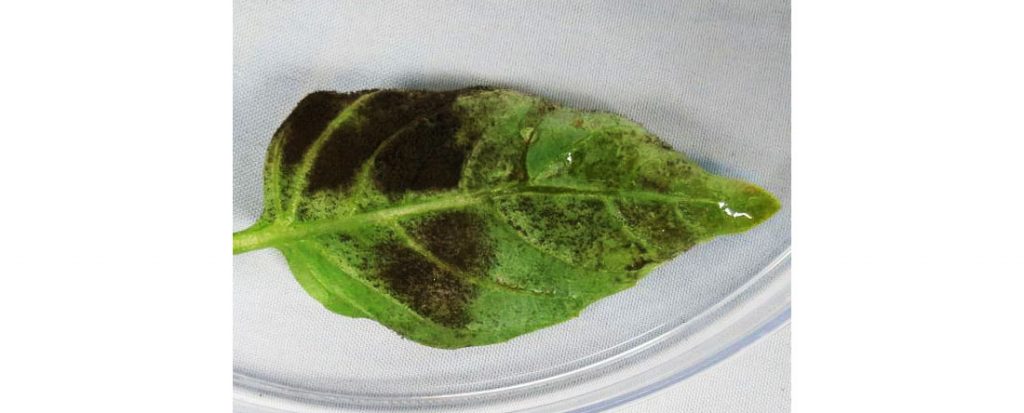
Investigate the possibility that your basil plants have developed basil downy mildew. This is a devastating disease that affects many types of basil. At first, you’ll see leaf yellowing, followed by leaf browning. Leaves will curl and wilt. Check the underside of the leaves for a gray-purple fuzzy material. I’ve listed some sites below where you can compare photographs of your affected leaves to leaves with basil downy mildew.
This is caused by a fungus-like organism called Peronospora belbahrii. It can come from contaminated seed, infected transplants, or from wind-blown spores. It spreads by wind, by rain and water splash, or by your hands, clothing or gardening tools that come in contact with an infected plant. It thrives in humid warm conditions and can spread very quickly, ruining your entire basil crop.
Unfortunately, there is no known cure. Once you see it on your plants you must take prompt action. You can harvest the healthy leaves that show no sign of disease. However, they should be used immediately so get out your favorite pesto recipe. The entire plant and all infected leaves should be bagged and disposed of in your garbage. Do not add this material to your compost pile.
Green-leafed varieties of sweet basil are most likely to develop basil downy mildew. To avoid this problem in the future, look for the sweet basil cultivars ‘Prospera’, ‘Rutgers Devotion’, ‘Rutgers Obsession’, ‘Rutgers Thunderstruck’ and ’Rutgers Passion’. They are new releases that have been naturally bred to be resistant to basil downy mildew. Purple-leafed varieties, Thai basil, lemon basil and spice basil are less susceptible to this disease.
Don’t plant your basil in the same spot year after year. Instead, rotate your crop. Grow your plants in a way that will keep them dry. Plant in a sunny location. Space plants as far apart as possible to increase air circulation. Avoid overhead watering, such as with a sprinkler. Water early in the morning so foliage dries quickly. Use a drip or soaker hose to water. If you use a watering can, wet only the soil, not the leaves.
Once it appears, fungicide treatments available to the home gardener are not likely to control the disease adequately, if at all. Using these products would be a waste of time, effort and money.
For a definitive diagnosis, bring a sample to the Craven County Cooperative Extension Center at 300 Industrial Drive in New Bern, or submit a sample to the Plant Disease and Insect Clinic at NCSU. Detailed information on how to do this is available at projects.ncsu.edu/cals/plantpath/extension/clinic/submit-sample.html.
Check any of these sites for pictures and more information: content.ces.ncsu.edu/basil-downy-mildew, hort.extension.wisc.edu/articles/basil-downy-mildew-2, hgic.clemson.edu/factsheet/basil
Submitted by Joanne Celinski on behalf of Judi Lloyd, Craven County Extension Master Gardener Volunteer Association

